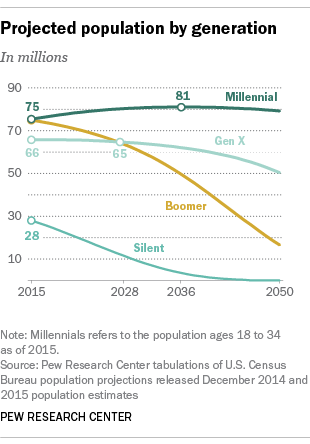Powering Your Growth with Boomers and Millennials
More employers are seeing flexible work environments or telework as a relatively inexpensive perk that improves work/life balance. In another study from California research firm Global Workplace Analytics, 95 percent of employers said the ability to telework has a significantly positive impact on employee retention, too.
Are you ready to attract new workers?
Millennials have surpassed Baby Boomers as the nation’s largest living generation, according to population estimates released this month by the U.S. Census Bureau. Millennials, whom we define as those ages 19-35 in 2016, now number 75.4 million, surpassing the 74.9 million Baby Boomers (ages 51-69). And Generation X (ages 35-50 in 2015) is projected to pass the Boomers in population by 2028.
The Millennial generation continues to grow as young immigrants expand its ranks. Boomers whose generation was defined by the boom in U.S. births following World War II are older and their numbers shrinking as the number of deaths among them exceeds the number of older immigrants arriving in the country.
Millennials have surpassed Baby Boomers as the nation’s largest living generation
So What About Generation X?
For a few more years, Gen Xers are projected to remain the “middle child” of generations caught between two larger generations of the Millennials and the Boomers. (The Gen X population is projected to outnumber the Boomers in 2028.)
While this group of potential personnel is smaller than Millennials, the generational span of Gen X (16 years) is shorter than the Millennials (17 years), Gen Xers are likely some of your best highly-skilled, high-potential leadership candidates. Today the oldest Gen Xer is now 50 and likely more motivated by finding the right fit instead of merely the highest wage. Telework offers them the flexibility they seek while new technologies arm them with the tools to be capable leaders to manage remote worker performance.
While younger Millennials are attractive additions to your team, don’t discount the Baby Boomers
Baby Boomers have always had an outsized presence compared with other generations. They were the largest generation and peaked at 78.8 million in 1999 and last year there were an estimated 74.9 million Boomers in 2015.
These folks come with a strong work ethic, time-tested know-how and dedication to a job well done. While wanting to enjoy the perks of retirement, they are attracted to flexible work schedules and don’t require the same level of health benefits or wage considerations because they see returning to work as an encore career where they can contribute without having to worry about getting home on time.
Why Baby Boomers are just as obsessed with technology as Millennials
If you watch the news or read articles on the Internet from time to time, you’ve probably heard that teenagers and Millennials are digital natives who constantly use Snapchat and Instagram or apps that only people who can’t legally drink know about.
However, the research firm, Pricenomics argues that for Baby Boomers, adult’s obsession with email leads us to be just as addicted to technology as are Millennials. We’re just doing different things with it:
Adult’s email addiction
- One survey has found that over 50% of employees check their company email over the weekend and before or after work.
- Another found that 40% of employees think it’s fine to respond to important work emails during family dinners.
- Yet another revealed that most workers expect responses to emails within an hour if not in minutes.
- Nearly 60% of adults check their work email while on vacation.
- 6% have checked their email while a spouse is in labor.
- Another 6% have checked email at a funeral, and 10% at a child’s school event.
Anyone that has eaten with teenagers (Generation Z) know they are obsessive about their smartphones. Marketers tell us they check their phones 150 times per day and they need instant gratification.
Millennials are described as “surfing paparazzi photos, logging onto Facebook… and uploading pictures of themselves while watching TV shows,” by the author of a book called The Dumbest Generation.
Young people are interacting all day, but almost entirely through a screen,” adds a reporter at TIME Magazine.
But if you want to characterize a large group of people, you want to have something to compare them to. And when you compare technology use among young people and middle-aged people, you discover something that, in hindsight, should seem pretty obvious at least to always-connected working parents.
Adults are as addicted if not more addicted to technology as teenagers.
Here, for example, are the findings of a Nielsen survey about which age groups are most distracted by technology during mealtimes:
Chart by Priceonomics; data via Nielsen Global Survey
The above chart shows how many members of each demographic said that they use technology during meals. Contrary to their technology-obsessed image, teenagers led the way in terms of tech-free meals, followed by Millennials.
Unfortunately, Nielsen did not ask specifically about habitually pulling out smartphones during dinner. But the survey results are a pretty remarkable denial of young people’s reputation as reliant on screens and technology.
This really shouldn’t be surprising. After all, just imagine if teenagers wrote thought-leadership articles about how adults use technology.
Adults, of course, have written plenty of think pieces about their smartphone addiction, and some particularly plugged-in workers have started attending “digital detoxes” weekends without phones and computers.
If you like to name your demons, psychologists Larissa Barber and Alecia Santuzzi have called the disease underlying adults smartphone addiction telepressure: the combination of a strong urge to be responsive to people at work through message-based [information and communications technologies] and a preoccupation with quick response times.
Adults relationship with connectivity and technology is probably not helped by the fact that an increasing share of workers needs to use social media at work whether it’s marketers on Facebook, recruiters on LinkedIn, or all desk workers on Slack. Call it the Slack Principle: social networks start as a place for teens to goof off, but once they monetize and find business applications, the adults arrive. You start with teens on AOL instant messenger and end with consultants collaborating over Slack.
While social networking may have started as a viral craze for U.S. teenagers, the CEO of Informate has said. It’s steadily matured into an everyday lifestyle for many adults around the world who are now eclipsing teens and young adults as most-frequent users.
Whatever twist of fate occurred to bring start-ups and
Venture Capitalists together, telework has benefited.
Today both Boomers and Millennials are large populations for your future personnel and both age groups highly value the benefits that work-from-home and telework environments offer. In closing, consider these facts:
-
Improves Employee Satisfaction
- 80% of employees consider telework a job benefit (saving them time, travel costs and easing the burden of family schedule coordination). Two-thirds of people want to work from home.
- 36% would choose it over a pay raise. A poll of 1,500 technology professionals revealed that 37% would take a pay cut of 10% if they could work from home.
- Millennials are more difficult to recruit (as reported by 56% of hiring managers) and to retain (as reported by 64% of hiring managers), but they are particularly attracted to flexible work arrangements (rating among benefits as an 8 on a 10 scale for impact on overall job satisfaction).
-
Reduces Staff Attrition
- Losing a valued employee can cost an employer $10,000 to $30,000.
- Recruiting and training a new hire costs thousands.
- 14% of Americans have changed jobs to shorten their commute.
- 46% of companies that allow teleworking say it has reduced attrition.
- 95% of employers say telework has a high impact on employee retention.
-
Increases Productivity
- In total, 67% of employers report increased productivity among their telecommuters.
- Fortune 100 companies including Best Buy, British Telecom, Dow Chemical, show that teleworkers are 35-40% more productive.
-
Saves Employers Money
- Nearly 60% of employers identify cost savings as a significant benefit to telecommuting
- Alpine Access Remote Call Center agents close 30% more sales than traditional agents the year before, while customer complaints decreased by 90%, and turnover decreased by 88%.





